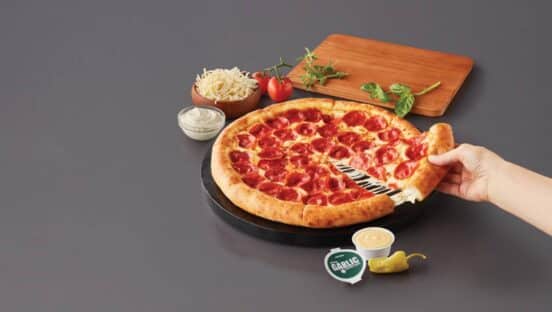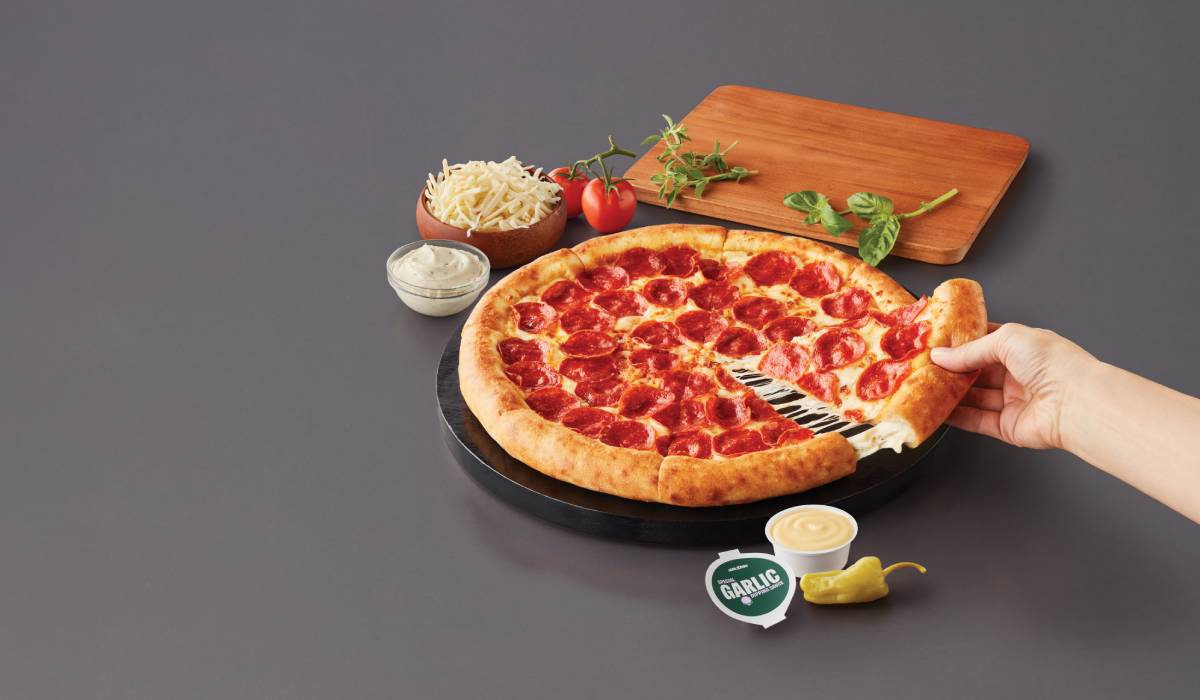Not unlike the wider pizza space, Papa Johns weaved through head and tailwinds throughout the past four years. The category raced to record performance in the wake of COVID’s onset and push toward off-premises, balanced recalibration as dine-in returned, and, more recently, faced pricing, labor, and commodity pressures among the most convoluted in the sector. But through it all, Papa Johns’ corporate and franchise teams in 2023 delivered their fourth straight year of positive North America comparable sales. CEO Rob Lynch on Monday said, as the brand sustained growth, it’s made foundational improvements in operations, digital solutions, and marketing platforms “as part of our efforts to evolve our business model for the next chapter of growth.”
Full-year North America comps
- 2023: 1 percent
- 2022: 1 percent
- 2021: 11.8 percent
- 2022: 17. 6 percent
Papa Johns is calling this ensuing stanza, “Back to Better 2.0,” which it announced Monday ahead of the ICR Conference in Orlando. “As we look to the future, we are optimizing our investments in data science and our marketing tech stack to unlock value for both the top and bottom lines,” he said in a statement.
READ MORE:
Papa Johns Zeroes in on Revenue Management
Papa Johns Navigates the Complex World of Pizza Pricing
Even After Record Sales, Papa Johns Sees Plenty of Upside Ahead
North America franchisees recently voted to “significantly” increase contributions to the company’s national marketing fund. This will help Papa Johns activate a new strategy in 2024, Lynch said, based on a review of the brand’s 2023 creative and media efforts. The company said it identified opportunities to improve audience selection, offer differentiated category solutions, improve marketing return on ad spend, sustain loyalty, and create cultural buzz.
Operators voted, as mentioned, to increase contribution rate to the fund by 20 percent, or 100 basis points of sales. “This will increase the productivity of their holistic marketing contributions by leveraging the scale national investments deliver,” Papa Johns said. “At the same time, the company has made local marketing optional for franchisees, resulting in a net decrease in required marketing spend and an opportunity to increase the overall profitability of their restaurants.”
Alongside the jump, Papa Johns unveiled what Lynch claimed was the largest development incentive in system history. The company said the program would “deliver significantly higher restaurant-level EBITDA margins during the first five years of operations through a waiver of national marketing fund contributions.” It’ll be made possible by improved productivity and scale of marketing investments outlined previously.
“This new incentive will significantly improve cash-on-cash paybacks for franchisees, add scale in key market, an attract growth-driven franchisees,” the company said.
Papa Johns opened a net of 45 restaurants globally in Q3. As of September 24, the brand had 5,825 units systemwide, including 3,397 in North America and 2,428 internationally.
Expansion is one topic that sat dormant before Lynch arrived in summer 2019. Papa Johns had posted two negative domestic unit growth calendars in 2018 and 2019. In North America, 128 locations shuttered in 2018 versus 79 opens. A year earlier, 186 franchises closed, along with seven corporate stores. And due to COVID, the brand opened just five net new stores stystemwide across 2020.
The brand debuted net 37 U.S. stores in 2022 at AUVs of $1.169 million. Across 2021, the figures were 30 and $1.147 million, respectively. Going back to pre-COVID life in 2019, Papa Johns boasted AUVs of $837,000 and had just closed 57 U.S. venues year-over-year.
Early last year, Papa Johns introduced a multi-year development goal of 1,400–1,800 net locations between 2022 and 2025, or global growth between 6–8 percent for fiscal years 2023 through 2025. Due to external challenges, the outlook was more recently reset to 5–7 percent and 1,150–1,400 units.
One corner of this growth conversation that’s always presented whitespace is international. Over the past decade, the brand more than doubled its overseas footprint and now operates in 50 countries and territories. “As we pursue the next phase of international growth, we are taking the necessary steps to evolve our business structure to deliver an enhanced value proposition to our customers and franchisees, ensure targeted investments and efficient resource management, and better position our largest markets, including the UK, for long-term, profitable growth and brand strength,” Papa Johns said Monday.
When Lynch came onboard, the brand had about half as many restaurants as its two largest competitors domestically and a third internationally. They were in nearly 100 countries and Papa Johns 48.
The company now announced multiple “transformation initiatives” to evolve its broader international business structure.
It starts with regional hubs. In order to provide a “frictionless, locally valued offering with a recognizable and consistent customer experience,” Papa Johns will establish hubs in its Asia Pacific, EMEA (Europe, Middle East, and Africa), and Latin America regions. These hubs will be led by GMs and teams who will partner with franchisees to create a holistic strategic to boost performance, Papa Johns said.
“These teams will align global best practices in operations, marketing and technology with local preferences and needs to accomplish Papa Johns’ long-term objective of increasing market share in key markets around the world,” the company noted.
Additionally, to further its ability to deliver menu innovations, targeted marketing, and enhanced value in international markets, Papa Johns said it would increase investment in consumer-facing tech, digital infrastructure, and enhanced reporting. It will expand ordering capabilities through its website and app and ability to leverage analytics, and, in turn, expects to improve purchase conversion, increase customer retention, and deliver faster consumer insights to franchisees, Papa Johns said.
Lastly, in hopes of solidifying its largest international market for long-term growth, Papa Johns shared it will focus on improving operational efficiency in the U.K. It closed “multiple low-performing, no-viable, franchised restaurants” in Q4, which amounted to 10 franchised stores going dark.
Papa Johns expects additional strategic closures this year.
The U.K. has been an evolving process for Papa Johns. This past June, the chain established a corporate portfolio in U.K. with the acquisition of 91 locations. It also recently bought 27 addition stores in July, bringing the total ownership up with 118 restaurants. The U.K. market, which boasted more than 450 Papa Johns at the time, was challenged in recent quarters (international comparable sales declined 4 percent in 2023 versus 2022).
As a result of these transformation initiatives, Papa Johns said it’s analyzing the potential non-cash lease impairments associated with strategic closures and loan impairments, along with other costs including employee expenses and professional service fees in connection. The company projects a portion of the costs will be incurred in Q4, with the remainder to be recognized in fiscal years 2024 and 2025.
Papa Johns also revealed a U.S. effort that revolves around its commissary business. To bump profitable growth and improve supply chain productivity, with an nod toward cost savings and incremental profit, the company said, it will increase the fixed operating margin U.S. commissaries charge by 100 basis points in each of the next four years, starting in 2024. That will move it from 4 to 8 percent by 2027. In total, Papa Johns noted the change would equate to roughly 100 basis points of cost at the restaurant level.
It added there would be “multiple initiatives employed to mitigate this cost.”
Firstly, Papa Johns plans to offer new opportunities for franchisees to earn annual incentive-based rebates as they increase volume and open new restaurants. Operators who lift case-volume purchases at the highest volume growth could realize target market rates lower than the current 4 percent rate in place today, Papa Johns said.
Secondly, the incremental volume drive by increased marketing and additional development will reduce the shared supply chain costs across the system. And finally, Papa Johns added, it will be “focused on driving continued productivity throughout the supply chain through improved operations and supplier relationships”
“Volume is what makes the supply chain more productive and more efficient, so we’ve created a commissary model that now offers rebates back to franchisees based on the amount of volume growth they deliver,” Lynch previously told QSR. “We’ll be able to discern who’s driving the growth, whether it’s through incremental transactions or new unit development, and make sure that we’re adjusting the rate structure that they have commensurate with the amount of growth that they’ve driven into the supply chain.”
In tandem with Monday’s “2.0” news, Papa Johns shared preliminary Q4 and full year results. Global systemwide sales were $1.3 billion in Q4, up about 12 percent from the prior-year period. Excluding a 53rd week in 2023, it was 3 percent higher. For the full fiscal year, systemwide global sales were $5 billion.
North America same-store sales, on a 13-week basis, climbed 2 percent over Q4 2022 as transaction and ticket growth delivered 2 percent comps at domestic company-owned stores and North America franchises. For the full calendar, North America same-store sales rose 1 percent, led by a 3 percent increase at domestic corporate units.
International comps declined 6 percent in Q4 and 4 percent full year versus the prior.
Papa Johns recorded 210 new unit opens in 2023, with 57 in North America and 153 in international markets. The company said the lower-than-anticipated net results were due to international closures. In addition to the 10 UK shutterings, 12 international venues were re-classified as closed locations through a review of temporary closures. Some openings moved into 2024 as well and others were delayed due to the ongoing conflict in the Middle Easter.
“It is our ambition to continue our positive momentum and to become the [quick-service] pizza brand of choice for customers and franchisees around the world,” Lynch said. “We are excited about Papa Johns’ future as the initiatives that we are undertaking, combined with our premium positioning in the marketplace, supportive franchisee base, and proven leadership team, will enable us to achieve our vision and deliver meaningful long-term value creation for all stakeholders.”








